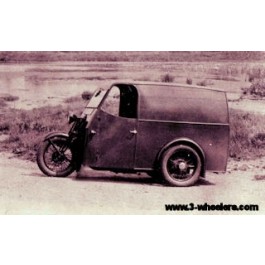The Reliant Motor Company was formed in 1935 when Tom Lawrence Williams built the first prototype vehicle in his garden at Kettlebrook, Tamworth (UK) along with Ewart.S.Thompson. A former Works Manager at Raleigh who had worked on their Raleigh Safety Seven T. L , Williams left the company to build his own 3-wheeler. He completed and licensed the vehicle on the 1st January 1935. This vehicle, “The Reliant”, was a 3 wheeled 7 cwt van powered by a single cylinder 600cc JAP engine which was then uprated to a twin cylinder JAP 747cc engine in 1936. It is believed Williams called the company Reliant as some of the old Raleigh parts he used had the initial R on them and so he needed a company name starting with the same letter. It was during a visit to the 1937 Commercial vehicle show that Reliant acquired the supply of the Austin 7 engine for their vehicles which they continued to use until 1939 when Reliant made their own 747cc side-valve engine that was closely based on the Austin 7.
With the onset of the second World War Reliant continued to produce vehicles until early 1940 when their attention was then turned to machining parts for the various ministries. After the war Reliant started to reproduce vehicles in 1946. In 1952 Williams decided to modify the body of the Reliant van to accommodate four people, and so in 1952 the Regal Mk 1 was exhibited at Earls Court. The Mk 1 had an aluminium body fixed to an Ash frame along with a convertible hood. Over the next few years the Reliant Regal took on many forms (See below for greater details) with the Mk2 in 1955 which started to use glass-fibre body panels. In 1956 the Mk 3 was the first all glass-fibre Reliant. The Regal was continuously improved upon with the Mk 4 in 1958, Mk 5 in 1959 and the Mk 6 in 1960 (The Mk 6 being Reliant’s last side-valve model).
In 1962 a major step forward was taken with the Regal 3/25. Instead of an internal wooden frame this had a unitary construction body of re-enforced glass fibre. Polyester was moulded in two major units (outer and inner) and then bonded together and bolted to a steel chassis. The vehicle was also powered by Reliant’s new 600cc OHV engine which was Britain’s first flowline production light alloy motor engine.
Reliant had been exporting the Regal as a pickup model to markets overseas and its success was such that in 1967 Reliant created a new pickup type vehicle, the TW9 with a 10cwt carrying capacity. The TW9 was easily adapted to be any kind of vehicle whether it be a pickup truck or a road sweeper. The vehicle also found a good market in the UK with a 16cwt capacity. It was also made under licence by BTB Engineering and sold as The Reliant Ant.
In 1969 the 700cc engine was introduced and Reliant’s production was such that it in 1969 the fifty thousandth 3/25 model was delivered. In 1969 Reliant took over Bond, another 3-wheeler manufacturer, and commissioned Ogle to produce a sports 3-wheeler for the "young" generation” that used the Bond name. This resulted in the Bond Bug that was sold from 1970 to 1974. Early Bugs used the 700cc engine though later ones used the 750cc engine when it was up rated once more in 1973.
In the same year Reliant introduced perhaps the most famous British 3-wheeler of all time, the “Reliant Robin”. This vehicle, powered by the 750cc engine, showed completely different styling and was available as a Saloon or an Estate. These first Robins were produced until 1975 when the Robin received more minor changes and a larger 850cc engine with a S.U carburettor.
In 1981 Reliant introduced the wedge-shaped Rialto which whilst still using the 850cc engine now featured a galvanised chassis. Such was the fame of the previous “Reliant Robin” the name was reintroduced in 1989 with the Reliant Robin Mk 2. The 1990’s were a turbulent time for Reliant who called in the receivers on October 25th 1990. The company was then brought by Beans Engineering for an estimated figure of £1.5 million but Beans were to call in the receivers four years later in November 1994. Reliant was then acquired by the Avonex Group on 16th January 1995, who also had to call in the receivers in December 1995 Reliant was then purchased in April 1996 by “a consortium of Businessmen”. From this point on business, for Reliant, had returned to normal and by the end of August 1996, production of the Reliant Robin had resumed. In the first full year 720 cars were built with Reliant also expanding into lightweight commercial vehicles. By 1999 Reliant had also moved into import and distribution with various new models that included the Ligier Microcar from France, the Piaggio Ape commercial vehicle from Italy.
Reliant production ceased in Tamworth in late 1998 and in January 1999 the Reliant company moved to new premises and to a new purpose built factory at Burntwood. (UK) In late February, Reliant introduced a new Reliant Robin Mk 3 Hatchback for the Millennium with a completely fresh design that was the first major change made to the Reliant Robin for 10 years. After an announcement on the 26th September 2000, Reliant ceased making 3-wheelers in February 2001 although original plans had been to stop production in December 2000. To mark 65 years (though it was actually 66 years by the time the last Reliant was made) of 3-wheeler production Reliant built Sixty five Special Edition Robins (Robin 65) that were individually numbered with a plaque on the dashboard. The last Reliant Robin was collected by its owner on February 14th 2001.
In April 2001 Reliant Cars moved their premises to Cannock. (UK) and in the same month B&N Plastics announced that they would continue to make the Reliant Robin under licence to Reliant and production officially started April 30th 2001 with the vehicles being officially launched on July 12th 2001 and delivered to Reliant dealers in January 2002. Unfortunately due to various problems production was put on hold towards the end of 2002. In 2010 Reliant celebrates its 75th birthday though today it only exist selling spare parts.
Reliant have made numerous 4-wheeler sports along side their 3-wheeler range over the years with both an economy range of vehicles (The Rebel, Kitten and Fox) and a range of sports cars (Scimitar and Sabre). Reliant’s 850cc engine has found its way into many items including fire pumps, lawn mowers, boats and in the 1980’s there was even the Quasar Motorcycle that was a revolutionary covered motorbike capable of 100mph+..










